
We have seen a lot of questions on the comparison of Infrastructure as Code (IAC) tools. And today, we want to answer all the important questions.
Terraform, Ansible, Chef vs Puppet, and Pulumi are essential tools for efficient and effective infrastructure management, enhancing operations, reducing errors, and accelerating development and deployment pipelines.
Enhance your organization’s efficiency and precision with the right IAC solution today.
Use the Link below to find the section that matters to you, the most:
- Ansible vs Chef vs Puppet vs Terraform
- Alternatives to Terraform Cloud
- Alternative to Terraform
- Ansible vs Pulumi
- Ansible vs Terraform
- AWS Terraform Alternative
- Azure Terraform Alternatives
- Chef Orchestration
- Chef Terraform
- Chef vs Puppet vs Ansible vs Terraform

1. Ansible vs Chef vs Puppet vs Terraform | (Comparison of Infrastructure as Code (IAC) Tools)
Four powerful DevOps technologies compete for your attention! Ansible, Chef, Puppet, and Terraform, all champions in their own right, compete for your automation support.
But who will be the leader of your infrastructure orchestra? Let’s examine their strengths and limitations in order to select the best champion for your DevOps adventure.
1.1. Ansible: the Agile Acrobat
- Module marketplace galore:
- Extend Ansible’s reach with its vibrant community-driven module ecosystem.
- Find pre-built modules for almost any task, from deploying applications to managing network switches, like a resourceful acrobat drawing tools from a bustling marketplace.
- Extend Ansible’s reach with its vibrant community-driven module ecosystem.
- Simple elegance:
- Playbooks in YAML weave automation magic, making Ansible accessible to novice and expert alike.
- Its ease of use and ad-hoc configuration prowess shine in quick deployments and dynamic environments.
- Playbooks in YAML weave automation magic, making Ansible accessible to novice and expert alike.
- Agentless and nimble:
- No installation on managed servers? Ansible thrives in remote execution, making it ideal for heterogeneous environments and cloud deployments.
- Think agility and flexibility, like a nimble acrobat traversing diverse terrain.
- No installation on managed servers? Ansible thrives in remote execution, making it ideal for heterogeneous environments and cloud deployments.
1.2. Chef, the Culinary Connoisseur:
- Application maestro:
- Chef cooks up intricate configurations with its Ruby DSL, managing not just servers but entire application lifecycles.
- Think cookbooks, a delectable array of pre-configured recipes, ensuring consistency and scalability for complex deployments.
- Chef cooks up intricate configurations with its Ruby DSL, managing not just servers but entire application lifecycles.
- Compliance connoisseur:
- Security is Chef’s forte. It integrates with compliance frameworks and enforces strict configurations, making it a trusted chef in regulated environments.
- Think of it as a meticulous master chef ensuring hygiene and quality in every dish.
- Security is Chef’s forte. It integrates with compliance frameworks and enforces strict configurations, making it a trusted chef in regulated environments.
- Deep server control:
- Chef delves into the heart of servers, configuring everything from software installs to user accounts.
- For granular control and intricate server-level automation, Chef shines like a chef wielding a masterfully honed knife.
- Chef delves into the heart of servers, configuring everything from software installs to user accounts.
1.3. Puppet, the String Puller:
- Declarative dominance:
- Puppet uses a declarative language, dictating the desired state of your infrastructure, leaving the “how” to its agent.
- Think of it as a puppet master pulling strings, ensuring the desired outcome without micromanaging the process.
- Puppet uses a declarative language, dictating the desired state of your infrastructure, leaving the “how” to its agent.
- Security stalwart:
- Puppet boasts rock-solid security features, making it a favorite in highly regulated environments.
- Its role-based access control and strict configuration enforcement keep systems secure like a vigilant puppet master guarding the stage.
- Puppet boasts rock-solid security features, making it a favorite in highly regulated environments.
- Large scale, high reliability:
- Puppet excels in managing vast, complex infrastructures.
- Its agent-based architecture and powerful reporting tools provide centralized control and comprehensive insights, making it the ideal puppeteer for a sprawling infrastructure orchestra.
- Puppet excels in managing vast, complex infrastructures.
1.4. Terraform, the Infrastructure Architect:
- Cloud native champion:
- Terraform builds your infrastructure landscape, sculpting cloud resources and network configurations with its declarative approach.
- Think of it as an architect, designing and provisioning the very foundation of your DevOps kingdom.
- Terraform builds your infrastructure landscape, sculpting cloud resources and network configurations with its declarative approach.
- Modular and reusable:
- Break down your infrastructure into manageable chunks with Terraform’s reusable modules.
- Code sharing and collaboration become effortless, like an architect sharing blueprints for efficient construction.
- Break down your infrastructure into manageable chunks with Terraform’s reusable modules.
- Multi-cloud agility:
- Terraform seamlessly traverses diverse cloud providers, making it the go-to tool for multi-cloud deployments.
- Think of it as a nimble architect traversing different worlds, building consistently across diverse terrains.
- Terraform seamlessly traverses diverse cloud providers, making it the go-to tool for multi-cloud deployments.
Choosing your Champion:
- Simple, ad-hoc automation: Ansible’s ease and flexibility rule.
- Complex applications, compliance focus: Chef reigns supreme.
- Large, regulated infrastructures: Puppet takes center stage.
- Pure infrastructure provisioning, multi-cloud agility: Terraform wins the race.
Remember, these 4 DevOps tools offers versatility. Combine these tools like master performers collaborating on a grand play.
- Use Chef for server-level configurations while Terraform lays the infrastructure groundwork.
- Utilize Ansible’s agility for ad-hoc tasks, and leverage Puppet’s security expertise for sensitive systems.
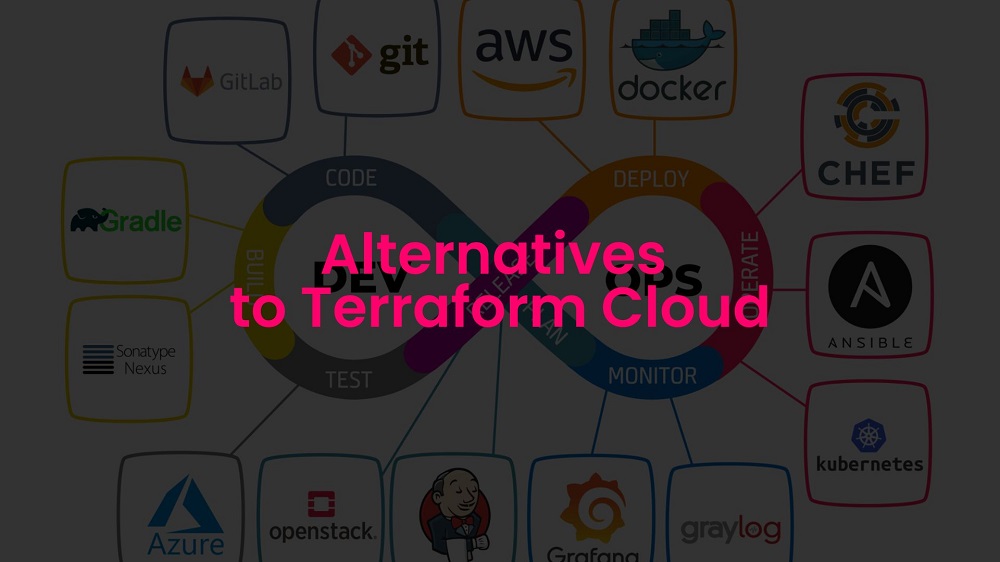
2. Alternatives to Terraform Cloud | (Comparison of Infrastructure as Code (IAC) Tools)
Terraform Cloud is a SaaS platform that provides additional features for Terraform users, such as collaboration and sharing, version control, automated workflows, and security and compliance.
If you are looking for alternatives to Terraform Cloud, some options to consider include:
- Ansible Tower
- Pulumi Enterprise
- Chef Infra
- Puppet Enterprise
Beyond Terraform Cloud: Unveiling the Automation Horizon
Terraform Cloud has carved its niche in infrastructure automation, but there’s a whole cosmos of alternatives waiting to be explored.
Whether you crave cost efficiency, advanced features, or simply seek a fresh perspective, consider these celestial navigators as you chart your DevOps course:
2.1. Env0: The Open-Source Star:
- Multi-tool mastery:
- Env0 transcends Terraform, Ansible, Pulumi, CloudFormation, and more.
- Imagine a versatile captain steering a multi-masted ship, tackling diverse infrastructure with adaptability.
- Env0 transcends Terraform, Ansible, Pulumi, CloudFormation, and more.
- Cost-conscious explorer:
- Ditch the subscription fees with Env0’s open-source architecture.
- Think of it as sailing the open seas, free from the constraints of commercial harbors.
- Ditch the subscription fees with Env0’s open-source architecture.
- Customization connoisseur:
- Craft your ideal automation journey with Env0’s extensive customization options.
- Tailor workflows, integrations, and security to your precise needs, like customizing your ship’s rigging for optimal performance.
- Craft your ideal automation journey with Env0’s extensive customization options.
2.2. Spacelift: The Feature-Rich Fleet:
- GitOps:
- Integrate seamlessly with Git workflows for enhanced control and reproducibility.
- Think of it as meticulously plotting your voyage using celestial charts, ensuring precision and traceability.
- Integrate seamlessly with Git workflows for enhanced control and reproducibility.
- Security:
- Robust security features and compliance capabilities keep your infrastructure safe and sound.
- Imagine impenetrable shields protecting your ship from digital pirates.
- Robust security features and compliance capabilities keep your infrastructure safe and sound.
- Unlimited:
- Enjoy extensive provider integrations, unlimited policies and tasks, and drift detection for proactive infrastructure management.
2.3. Scalr: The Agile Pathfinder:
- CI/CD integration:
- Bridge the gap between infrastructure and application development with seamless CI/CD integration.
- Think of it as streamlining your journey, connecting ports and navigating smoothly between destinations.
- Bridge the gap between infrastructure and application development with seamless CI/CD integration.
- Collaboration champion:
- Foster teamwork with role-based access control and intuitive dashboards.
- Imagine a crew working in harmony, each member navigating their role with clear charts and shared goals.
- Foster teamwork with role-based access control and intuitive dashboards.
- Cost optimization expert:
- Reduce infrastructure spend with Scalr’s intelligent automation and resource optimization tools.
- Think of it as charting an efficient course, cutting through unnecessary detours and saving resources.
- Reduce infrastructure spend with Scalr’s intelligent automation and resource optimization tools.
Making your Choice:
- Open-source advocate, budget-conscious: Env0 beckons.
- Feature-hungry, security-focused: Spacelift awaits.
- CI/CD enthusiast, cost optimizer: Scalr welcomes you aboard.
Remember, the vast ocean of automation alternatives holds countless treasures.
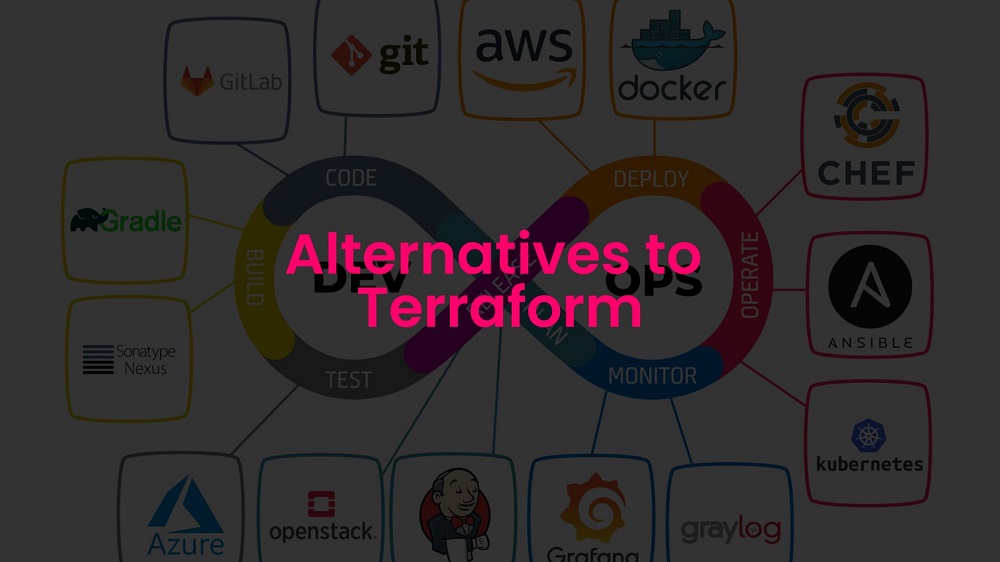
3. Alternative to Terraform (Alternatives to Terraform)
We have already created a complete guide on Alternative to Terraform — (Alternatives to Terraform) — you check check it out
Terraform is a popular infrastructure as code (IaC) tool, but it is not the only one. There are a number of alternatives to Terraform, each with its own strengths and weaknesses.
3.2 Some popular alternatives to Terraform include:
- Ansible
- Pulumi
- Chef
- Puppet
- AWS CloudFormation
- Azure Resource Manager
- Google Cloud Deployment Manager
When choosing an alternative to Terraform, it is important to consider your specific needs and requirements.
For example, if you are looking for a tool that is easy to use and get started with, Ansible may be a good option.
If you are looking for a tool that is more powerful and flexible, Pulumi or Chef may be better choices.
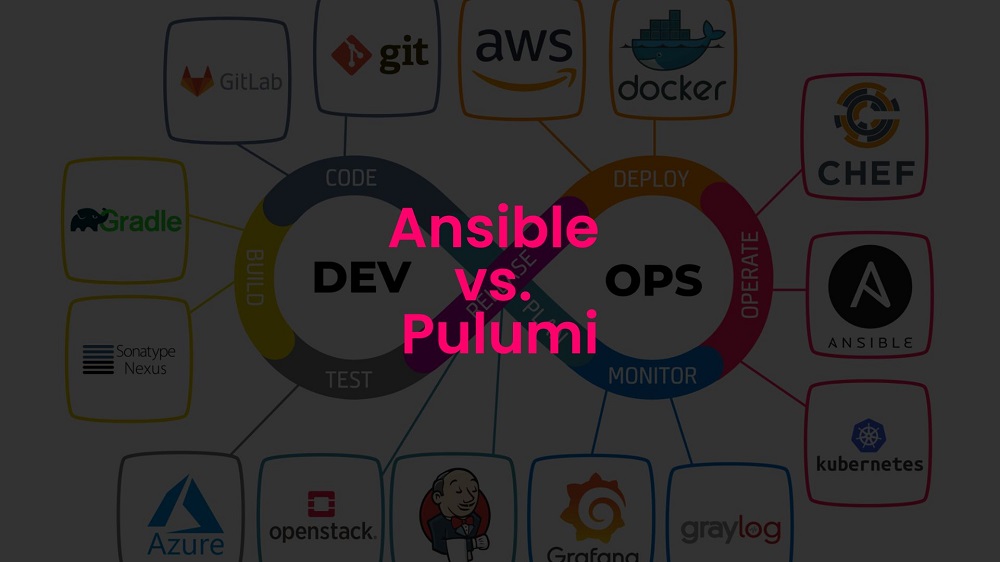
4. Ansible vs Pulumi | (Comparison of Infrastructure as Code (IAC) Tools)
In the DevOps coliseum, Ansible and Pulumi clash for automation supremacy. But who wields the baton with greater finesse?
Let’s dissect their strengths and weaknesses to find the ideal conductor for your infrastructure orchestra.
4.1. Ansible:
- Agile acrobat:
- Playbooks in YAML make automation accessible for all.
- Deployments and configurations become swift and ad-hoc, like acrobatic feats performed with effortless grace.
- Playbooks in YAML make automation accessible for all.
- Agentless and nimble:
- No pesky installations on managed servers.
- Ansible thrives in diverse environments, executing tasks remotely with the agility of a nimble dancer leaping across stages.
- No pesky installations on managed servers.
- Module marketplace galore:
- Extend your reach with a vibrant community-driven module ecosystem.
- Find pre-built tools for almost any task, like an orchestra conductor choosing instruments from a bustling marketplace.
- Extend your reach with a vibrant community-driven module ecosystem.
4.2. Pulumi:
- Language maestro:
- Compose infrastructure as code using familiar languages like Python or JavaScript.
- Enjoy the precision and expressiveness of a seasoned musician wielding a well-tuned instrument.
- Compose infrastructure as code using familiar languages like Python or JavaScript.
- Cloud native champion:
- Pulumi integrates seamlessly with major cloud providers, making it the go-to tool for multi-cloud deployments.
- Think of it as a conductor leading a diverse orchestra, harmonizing the melodies of different cloud platforms.
- Pulumi integrates seamlessly with major cloud providers, making it the go-to tool for multi-cloud deployments.
- State management finesse:
- Pulumi handles infrastructure state reliably, ensuring consistency.
- Avoiding configuration clashes like a conductor meticulously tuning each instrument before the performance.
- Pulumi handles infrastructure state reliably, ensuring consistency.
4.3. Choosing your Conductor: Ansible vs Pulumi
- Simple, ad-hoc automation with low barriers to entry: Ansible takes center stage.
- Complex infrastructure, multi-cloud deployments, and familiar programming languages: Pulumi leads the orchestra.
As usual — combine these tools for optimal harmony. Use Ansible for quick configurations while Pulumi lays the infrastructure groundwork.
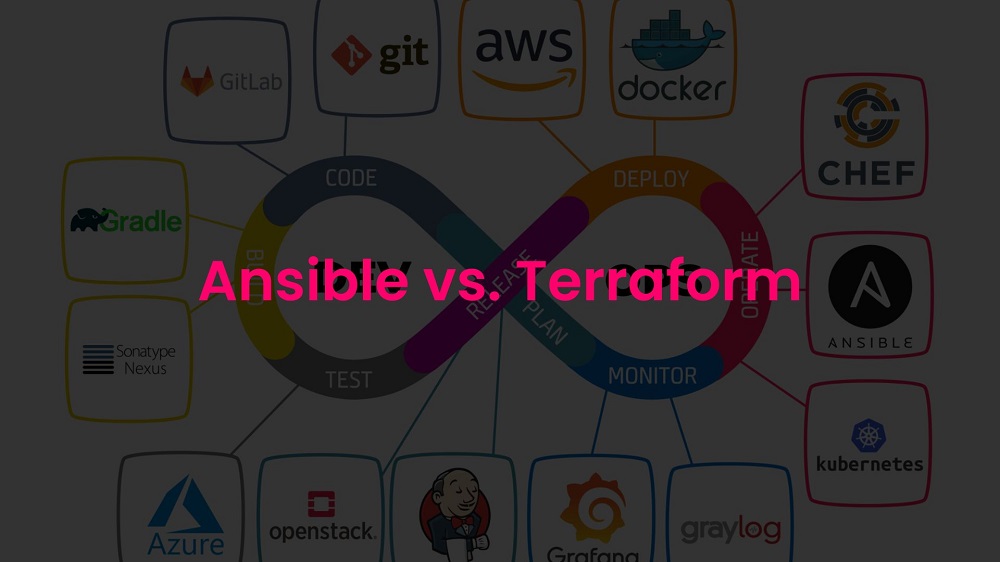
5. Ansible vs Terraform | (Comparison of Infrastructure as Code (IAC) Tools)
In the DevOps arena, Ansible and Terraform engage in a fierce automation battle. But who wields the code with greater power?
Let’s dissect their technical specialties to determine the champion for your infrastructure needs.
5.1. Ansible:
- Configuration Management:
- Its core strength lies in managing existing systems, deploying applications, and applying configurations swiftly.
- Think of it as a nimble surgeon performing precise adjustments on individual servers.
- Its core strength lies in managing existing systems, deploying applications, and applying configurations swiftly.
- Agentless and Modular:
- No agent installation required, making it flexible for heterogeneous environments.
- Its extensive community-driven modules offer pre-built automation for diverse tasks, akin to a vast toolbox for any configuration need.
- No agent installation required, making it flexible for heterogeneous environments.
- YAML Playbooks:
- Simple and accessible syntax lowers the barrier to entry, ideal for ad-hoc tasks and small-scale deployments.
- But complex infrastructure configurations can become unwieldy.
- Simple and accessible syntax lowers the barrier to entry, ideal for ad-hoc tasks and small-scale deployments.
5.2. Terraform:
- Infrastructure Provisioning:
- Terraform is a master at building cloud resources and network configurations from scratch.
- Think of it as a meticulous architect crafting your entire infrastructure landscape with code.
- Terraform is a master at building cloud resources and network configurations from scratch.
- Declarative Approach:
- Specify the desired state of your infrastructure, and Terraform orchestrates the steps to achieve it.
- This simplifies management and prevents configuration drift.
- Specify the desired state of your infrastructure, and Terraform orchestrates the steps to achieve it.
- Multi-Cloud Agnostic:
- Terraform supports major cloud providers seamlessly, enabling consistent deployments across diverse environments.
- However, server-level configuration adjustments, Ansible’s forte, might require additional tools.
- Terraform supports major cloud providers seamlessly, enabling consistent deployments across diverse environments.
5.3. Choosing Your Ally: Ansible vs Terraform
- Agile configuration management, diverse environments, quick deployments: Ansible excels.
- Large-scale infrastructure provisioning, multi-cloud deployments, consistent configurations: Terraform reigns supreme.
Remember, true mastery lies in collaboration.
Combine Ansible’s agility with Terraform’s architectural prowess for optimal automation.
Choose the tool that empowers your specific DevOps vision and build your infrastructure kingdom with precision and efficiency.

6. AWS Terraform Alternative | (Comparison of Infrastructure as Code (IAC) Tools)
If you are looking for an alternative to Terraform for managing AWS infrastructure, some options to consider are discussed below.
While Terraform shines as a popular tool for managing AWS infrastructure, the DevOps landscape offers a universe of alternatives, each catering to specific needs and preferences.
Let’s break free from the AWS orbit and explore three celestial navigators for your automation journey:
6.1. Pulumi:
- Familiar language mastery:
- Craft infrastructure as code using languages like Python or JavaScript, leveraging their expressiveness and familiarity.
- Think ditching cryptic dialects for your native tongue, writing infrastructure code with ease.
- Craft infrastructure as code using languages like Python or JavaScript, leveraging their expressiveness and familiarity.
- Cloud native champion:
- Pulumi integrates seamlessly with major cloud providers, including AWS, Azure, and GCP.
- Think of it as a multilingual ambassador, navigating effortlessly across diverse cloud territories.
- Pulumi integrates seamlessly with major cloud providers, including AWS, Azure, and GCP.
- State management finesse:
- Pulumi handles infrastructure state with robust features, ensuring consistency and preventing configuration drift.
- Think of it as a meticulously maintained map, guiding your infrastructure journey without getting lost.
- Pulumi handles infrastructure state with robust features, ensuring consistency and preventing configuration drift.
6.2. CloudFormation:
- Native AWS expertise:
- Deeply integrated with AWS services, CloudFormation offers granular control and pre-built templates for common AWS configurations.
- Think of it as a seasoned AWS guide, knowing the ins and outs of the cloud like the back of its hand.
- Deeply integrated with AWS services, CloudFormation offers granular control and pre-built templates for common AWS configurations.
- Cost-effective option:
- No additional subscription fees for using CloudFormation within your AWS ecosystem.
- Think of it as streamlining your expenses, utilizing a built-in tool and avoiding extra bills.
- No additional subscription fees for using CloudFormation within your AWS ecosystem.
- Learning curve for non-AWS environments:
- Familiarity with AWS CLI and structure is beneficial for navigating CloudFormation effectively.
- Think of it as a specialized language requiring some immersion before fluency.
- Familiarity with AWS CLI and structure is beneficial for navigating CloudFormation effectively.
6.3. Ansible:
- Agentless and dynamic:
- No agent installation required, making Ansible perfect for heterogeneous environments and ad-hoc configurations.
- Think of it as a nimble acrobat traversing diverse landscapes, adapting to any infrastructure context.
- No agent installation required, making Ansible perfect for heterogeneous environments and ad-hoc configurations.
- Module magic:
- Extensive community-driven modules offer pre-built automation for various tasks, including AWS management.
- Think of it as a vast library of spells, casting automation for almost any cloud need.
- Extensive community-driven modules offer pre-built automation for various tasks, including AWS management.
- Simple syntax with potential complexity:
- Playbooks in YAML provide an easy entry point, but large-scale AWS configurations can become cumbersome.
- Think of it as a language with a gentle beginning but potentially intricate grammar later.
- Playbooks in YAML provide an easy entry point, but large-scale AWS configurations can become cumbersome.
6.4. Choosing Your Cloud Compass:
- Familiar languages, multi-cloud agility, state management: Pulumi beckons.
- Deep AWS expertise, cost efficiency within AWS: CloudFormation awaits.
- Agentless flexibility, module diversity, adaptation to non-AWS: Ansible welcomes you aboard.
Remember, the cloud is vast, and these are just three stars in the automation constellation.
Explore other options like OpenFaaS, SaltStack, Kubernetes or even AWS Systems Manager and AWS CDK (Cloud Development Kit).
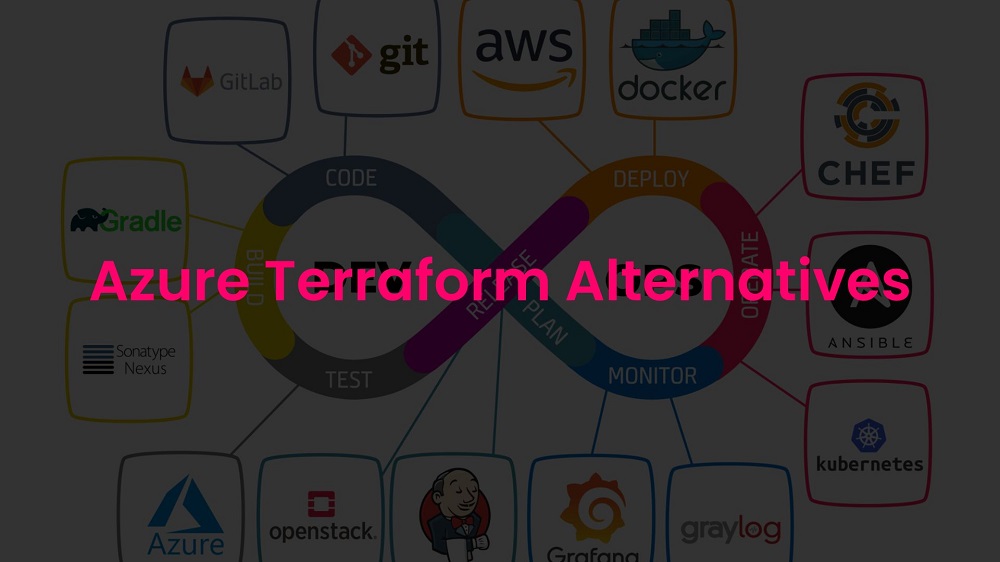
7. Azure Terraform Alternatives | (Comparison of Infrastructure as Code (IAC) Tools)
If you are looking for an alternative to Terraform for managing Azure infrastructure, some options to consider are discussed below.
While Terraform thrives in Azure infrastructure management, the DevOps cosmos offers a plethora of alternatives, each catering to diverse needs and preferences.
7.1. Bicep | Azure Bicep
- Native Azure fluency:
- Deeply integrated with Azure services, Bicep offers comprehensive control and pre-built templates for common Azure configurations.
- Think of it as a fluent Azure speaker, understanding the nuances of the platform like a native.
- Deeply integrated with Azure services, Bicep offers comprehensive control and pre-built templates for common Azure configurations.
- Limited multi-cloud:
- Bicep currently focuses primarily on Azure, with limited support for other clouds.
- Think of it as an expert Azure guide, but needing additional maps for exploring other cloud territories.
- Bicep currently focuses primarily on Azure, with limited support for other clouds.
7.2. Pulumi:
- Familiar language mastery:
- Craft infrastructure as code using languages like Python or JavaScript, leveraging their expressiveness and familiarity.
- Think of it as ditching cryptic dialects for your native tongue, writing infrastructure code with ease.
- Craft infrastructure as code using languages like Python or JavaScript, leveraging their expressiveness and familiarity.
- Cloud native champion:
- Pulumi integrates seamlessly with major cloud providers, including Azure, AWS, and GCP.
- Think of it as a multilingual ambassador, navigating effortlessly across diverse cloud territories.
- Pulumi integrates seamlessly with major cloud providers, including Azure, AWS, and GCP.
- State management finesse:
- Pulumi handles infrastructure state with robust features, ensuring consistency and preventing configuration drift.
- Think of it as a meticulously maintained map, guiding your infrastructure journey without getting lost.
- Pulumi handles infrastructure state with robust features, ensuring consistency and preventing configuration drift.
7.3. Ansible:
- Agentless and dynamic:
- No agent installation required, making Ansible perfect for heterogeneous environments and ad-hoc configurations.
- Think of it as a nimble acrobat traversing diverse landscapes, adapting to any infrastructure context.
- No agent installation required, making Ansible perfect for heterogeneous environments and ad-hoc configurations.
- Module magic:
- Extensive community-driven modules offer pre-built automation for various tasks, including Azure management.
- Think of it as a vast library of spells, casting automation for almost any cloud need.
- Extensive community-driven modules offer pre-built automation for various tasks, including Azure management.
- Simple syntax with potential complexity:
- Playbooks in YAML provide an easy entry point, but large-scale Azure configurations can become cumbersome.
- Think of it as a language with a gentle beginning but potentially intricate grammar later.
- Playbooks in YAML provide an easy entry point, but large-scale Azure configurations can become cumbersome.
7.4. Choosing Your Azure Compass:
- For deep Azure expertise, familiar syntax, ease of integration: Bicep beckons.
- For familiar languages, multi-cloud agility, state management: Pulumi awaits.
- For agentless flexibility, module diversity, adaptation to non-Azure: Ansible welcomes you aboard.
Remember, the cloud is vast, and these are just three stars in the automation constellation. Explore other options like Azure Resource Manager templates (ARM), CloudFormation, Azure Automation, and ARM CLI.
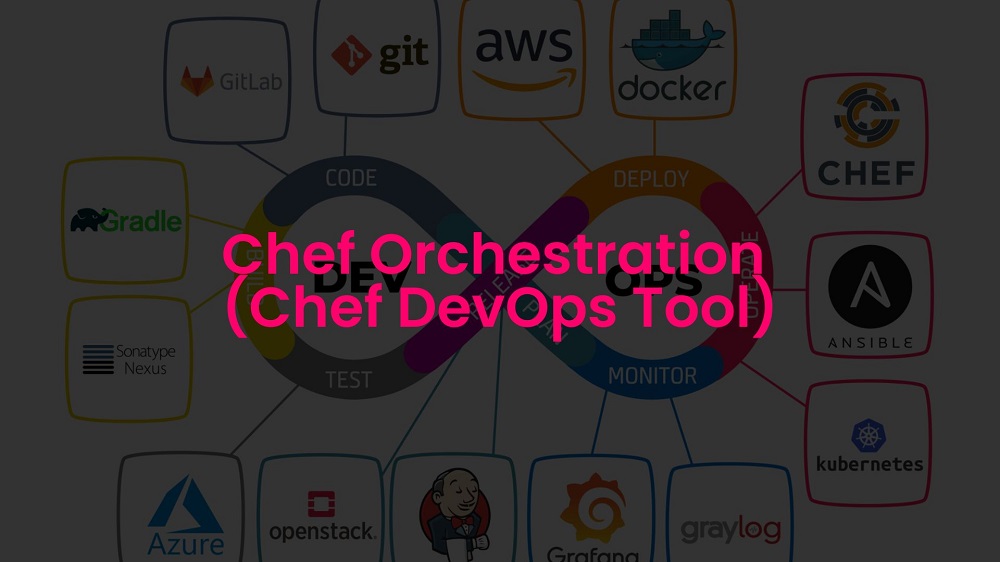
8. Chef Orchestration (Chef DevOps Tool) | (Comparison of Infrastructure as Code (IAC) Tools)
Chef can be used to orchestrate the deployment and configuration of infrastructure across multiple servers. This can be useful for large and complex infrastructure environments.
The Chef DevOps tool can also be used to implement DevOps security best practices and enable continuous integration and continuous delivery (CI/CD).
8.1. Chef Orchestration: Conductor of the DevOps Symphony
Chef orchestration weaves a melody of automation, transforming your DevOps landscape into a harmonious performance. But what exactly does it do, and how can it benefit your team?
8.2. Beyond Configuration Management:
While Chef excels at configuring individual servers, its orchestration features take it a step further.
Imagine Chef not just tuning each instrument — but conducting the entire orchestra, ensuring seamless cooperation and precise execution.
8.3. The Maestro’s Toolkit: Here’s what Chef brings to the table:
- Choreography through Roles and Profiles:
- Define configurations for groups of servers using Roles and apply them dynamically with Profiles.
- Think of them as sheet music for different sections of the orchestra, ensuring consistency and precision.
- Define configurations for groups of servers using Roles and apply them dynamically with Profiles.
- Workflow Coordination:
- Build complex automation workflows with Chef Solo and Knife Solo.
- Chain tasks together
- Schedule deployments,
- And handle contingencies, — like a conductor guiding the music’s flow.
- Build complex automation workflows with Chef Solo and Knife Solo.
- Converge with Confidence:
- Leverage Chef’s convergence engine to ensure consistent server states across your infrastructure.
- Think of Chef as —tuning each instrument before the performance, ensuring everyone is in sync.
- Leverage Chef’s convergence engine to ensure consistent server states across your infrastructure.
- State Transparency:
- Track changes and monitor configurations with Chef Compliance.
- Analyze server states,
- pinpoint inconsistencies,
- Maintain compliance,
- Like a keen-eyed conductor ensuring every note rings true.
- Track changes and monitor configurations with Chef Compliance.
8.4. Tuning your DevOps Performance: with Chef Orchestration
- Large, complex infrastructure:
- Chef orchestration shines where multiple servers collaborate, orchestrating deployments, rollbacks, and configuration changes with precision.
- Reduced manual effort:
- Automation takes center stage, freeing up time for strategic tasks and reducing human error. Consistency and repeatability become your new rhythm.
- Improved Agility:
- Respond quickly to changes and deploy updates seamlessly.
- Think of it as seamlessly improvising during the performance, keeping the music flowing even with unexpected twists.
- Respond quickly to changes and deploy updates seamlessly.
But there’s no one-size-fits-all conductor. Consider your team’s skills, existing tools, and infrastructure complexity before composing your Chef symphony.
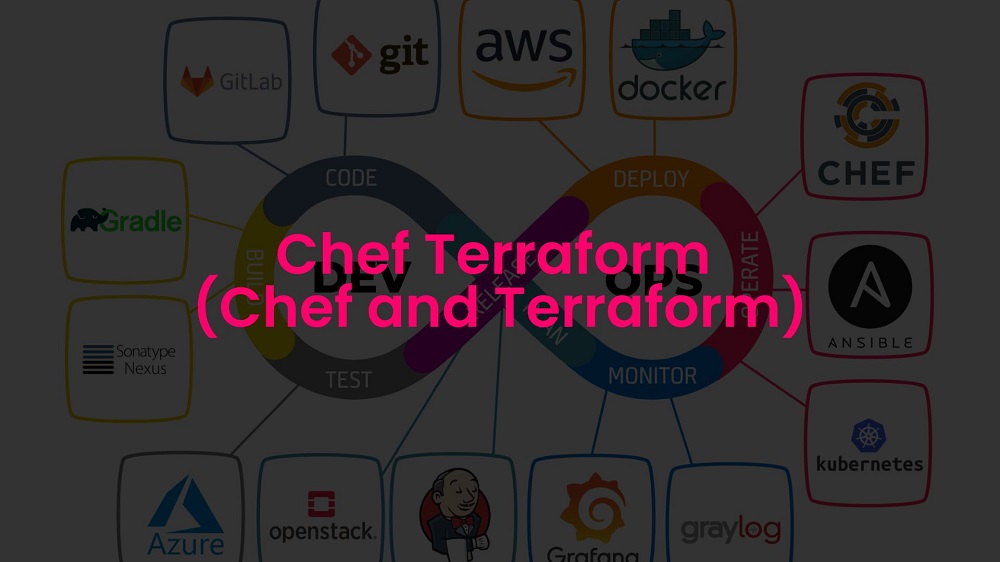
9. Chef Terraform (Chef and Terraform)
Yes — Chef and Terraform can be used together to manage infrastructure. Chef can be used to provision and configure infrastructure, — while Terraform can be used to manage infrastructure in the cloud.
9.1. Chef vs. Terraform: Navigating the DevOps Options
In the vast DevOps options, two stars blaze brightly: Chef and Terraform.
Both enables configuration management and automation, but with distinct celestial trajectories.
Deciding which tool fuels your DevOps journey requires peeling back their layers and understanding their strengths and weaknesses.
9.2. Chef, the great option:
- Master of configuration: Chef excels at orchestrating complex server environments, managing everything from software installations to user accounts.
- Its Ruby DSL offers granular control, but can be daunting for beginners.
- Application maestro: Chef shines in managing application lifecycles, deploying and scaling code with finesse.
- Think cookbooks, a treasure trove of pre-configured recipes for common tasks, bringing automation ease.
- Security navigator: Chef boasts robust security features, integrating with compliance frameworks and enforcing strict configurations.
9.3. Terraform, the nimble pioneer:
- Infrastructure architect: Terraform’s domain is pure infrastructure provisioning.
- From cloud resources to network configurations, it sculpts your infrastructure landscape using a declarative approach.
- Cloud native explorer: Terraform seamlessly integrates with various cloud providers, making it the go-to tool for multi-cloud deployments.
- Its has extensive plugins coverage — thus letting you manage diverse infrastructure with ease.
- Code reusability champion: Terraform’s modular, reusable modules break down infrastructure into manageable chunks, fostering code sharing and collaboration.
9.4. Choosing your path:
- Complex server environments, deep configuration needs: Chef’s rich capabilities and application focus come at the cost of a steeper learning curve.
- Infrastructure-centric automation, cloud agility: Terraform’s simplicity and cloud-native expertise shine for provisioning and managing infrastructure across diverse environments.
9.5. Beyond the binary:
Don’t get caught in the Chef vs. Terraform orbit. Think of them as complimentary tools, each illuminating different aspects of your DevOps journey. You can:
- Use Chef for server-level configuration and Terraform for infrastructure provisioning.
- Leverage Chef’s cookbooks for application management on Terraform-provisioned servers.
- Blend both tools for different tasks within a project, catering to specific needs.
Remember, the best tool is the one that unlocks your DevOps potential
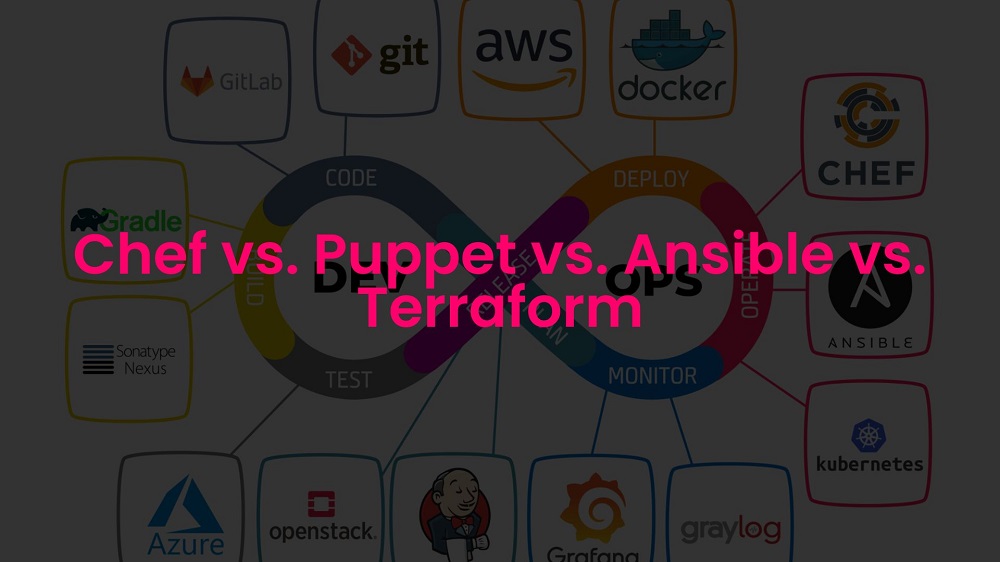
10. Chef vs Puppet vs Ansible vs Terraform | Chef vs Ansible vs Terraform | (Comparison of Infrastructure as Code (IAC) Tools)
This phrase is a comparison of the four most popular IaC tools. It seeks to discuss the strengths and weaknesses of each tool, and compare and contrast their features.
Chef, Puppet, Ansible, Terraform: A Configuration Management Showdown
In the modern DevOps world, managing infrastructure efficiently is crucial.
This is where configuration management tools (CMTs) like Chef, Puppet, Ansible, and Terraform comes in.
But with so many options, choosing the right tool can be overwhelming. Let’s break down their strengths and weaknesses to help you decide.
10.1. Chef
- The granddaddy of CMTs, Chef emphasizes complex infrastructure with a flexible Ruby DSL.
- Chef excels at managing servers, applications, and databases.
- Think of it as a “Swiss Army knife” for configuration,
- But Chef’s complexity can be a learning curve.
- Think of it as a “Swiss Army knife” for configuration,
- Chef excels at managing servers, applications, and databases.
10.2. Puppet:
- Another veteran, Puppet boasts a declarative language and strong security features, making it ideal for large, regulated environments.
- However, its agent-based architecture and slower iteration times can be drawbacks.
10.3. Ansible
- Embracing simplicity, Ansible uses playbooks in YAML, simplifying automation for diverse environments.
- It shines in quick deployments and ad-hoc configurations
- But for complex, multi-platform scenarios, it may lack power.
- It shines in quick deployments and ad-hoc configurations
10.4. Terraform
- The new kid on the block, Terraform focuses on infrastructure provisioning
- Managing everything from cloud resources to network configurations.
- Its declarative approach and code reusability make it efficient
- But Terraform is not as adept at server-level configuration as the others.
- Its declarative approach and code reusability make it efficient
- Managing everything from cloud resources to network configurations.
10.5. Choosing the Champion: (Chef vs Puppet vs Ansible vs Terraform)
- Complex multi-server, application-centric: Chef
- Large, regulated environments with security focus: Puppet
- Simple deployments, ad-hoc configurations: Ansible
- Pure infrastructure provisioning and cloud management: Terraform
10.6. Beyond the Big Four:
Consider factors like team skills, existing tooling, and future needs. You might even mix and match these tools for different tasks.
And finally, never forget that the ‘best’ tool is the one that best suits your specific needs.
POSTED IN: Cloud Computing